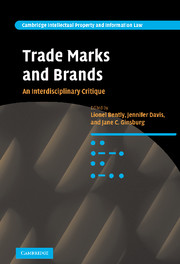Book contents
- Frontmatter
- Contents
- List of figures and tables
- Notes on the contributors
- Editors' preface
- Table of cases
- Table of statutes
- Part I Legal and economic history
- Part II Current positive law in the EU and the USA
- 3 Between a sign and a brand: mapping the boundaries of a registered trade mark in European Union Trade mark law
- 4 “See me, feel me, touch me, hea[r] me” (and maybe smell and taste me too): I am a trademark a – US perspective
- Part III Linguistics
- Part IV Marketing
- Part V Sociology
- Part VI Law and Economics
- Part VII Philosophy
- Part VIII Anthropology
- Part IX Geography
- Bibliography
- Index
- Titles in the series
3 - Between a sign and a brand: mapping the boundaries of a registered trade mark in European Union Trade mark law
Published online by Cambridge University Press: 13 April 2010
- Frontmatter
- Contents
- List of figures and tables
- Notes on the contributors
- Editors' preface
- Table of cases
- Table of statutes
- Part I Legal and economic history
- Part II Current positive law in the EU and the USA
- 3 Between a sign and a brand: mapping the boundaries of a registered trade mark in European Union Trade mark law
- 4 “See me, feel me, touch me, hea[r] me” (and maybe smell and taste me too): I am a trademark a – US perspective
- Part III Linguistics
- Part IV Marketing
- Part V Sociology
- Part VI Law and Economics
- Part VII Philosophy
- Part VIII Anthropology
- Part IX Geography
- Bibliography
- Index
- Titles in the series
Summary
In 2004, the easyGroup, best known for its airline, easyJet, announced the launch of a mobile phone service, easyMobile. The service was widely advertised using the colour orange, which had traditionally been associated with the Group's many other ‘easy’ products and services. In February 2005, Orange Personal Communications Ltd (Orange), which also provides a mobile phone service associated with the colour orange, initiated proceedings for passing off and registered trade mark infringement against easyGroup. Orange is the proprietor of a large number of registered trade marks (both UK and Community trade marks) for a broad variety of goods and services. Its registered marks include the word orange, the colour orange and marks combining both word and colour. In the UK it had registered the colour orange to be used, inter alia, with electronic communications apparatus and instruments. Orange alleged that the association of the colour orange with easyMobile would confuse customers as to the source of the latter's service. But Orange made it clear that its concerns went beyond possible customer confusion. It was also concerned that by using the colour orange on its mobile service, easyMobile would damage the Orange ‘brand’. According to a spokesman, ‘Our brand, and the rights associated with it, are extremely important to us. In the absence of any firm commitment from Easy [not to use orange], we have been left with no choice but to start an action for trademark infringement and passing off.’ Orange has valued its brand as worth 6.6 billion Euros.
- Type
- Chapter
- Information
- Trade Marks and BrandsAn Interdisciplinary Critique, pp. 65 - 91Publisher: Cambridge University PressPrint publication year: 2008
- 7
- Cited by

